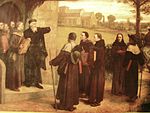Related Research Articles
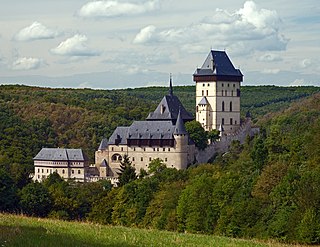
Bohemia is the westernmost and largest historical region of the Czech Republic. Bohemia can also refer to a wider area consisting of the historical Lands of the Bohemian Crown ruled by the Bohemian kings, including Moravia and Czech Silesia, in which case the smaller region is referred to as Bohemia proper as a means of distinction.
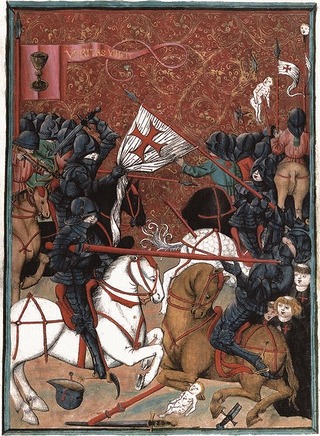
The Hussites were a Czech proto-Protestant Christian movement, with influences from both the Byzantine Rite and John Wycliffe, and that followed the teachings of reformer Jan Hus, a part of the Bohemian Reformation.

Jan Hus, sometimes anglicized as John Hus or John Huss, and referred to in historical texts as Iohannes Hus or Johannes Huss, was a Czech theologian and philosopher who became a Church reformer and the inspiration of Hussitism, a key predecessor to Protestantism, and a seminal figure in the Bohemian Reformation. Hus is considered to be the first Church reformer, even though some designate the theorist John Wycliffe. His teachings had a strong influence, most immediately in the approval of a reformed Bohemian religious denomination and, over a century later, on Martin Luther.
Year 1434 (MCDXXXIV) was a common year starting on Friday of the Julian calendar.

Ladislaus V, more commonly known as Ladislausthe Posthumous, was Duke of Austria and King of Hungary, Croatia and Bohemia. He was the posthumous son of Albert of Habsburg with Elizabeth of Luxembourg. Albert had bequeathed all his realms to his future son on his deathbed, but only the estates of Austria accepted his last will. Fearing an Ottoman invasion, the majority of the Hungarian lords and prelates offered the crown to Vladislaus III of Poland. The Hussite noblemen and towns of Bohemia did not acknowledge the hereditary right of Albert's descendants to the throne, but also did not elect a new king.

Jan Žižka z Trocnova a Kalicha was a Czech military leader, a contemporary and follower of Jan Hus, and a prominent Radical Hussite who led the Taborite faction during the Hussite Wars. Renowned for his exceptional military skill, Žižka is celebrated as a Czech national hero. Nicknamed "One-eyed Žižka" after losing one eye, he later became completely blind. Despite his blindness, Žižka led the Hussite forces in battles against three crusades and remained undefeated throughout his military career.
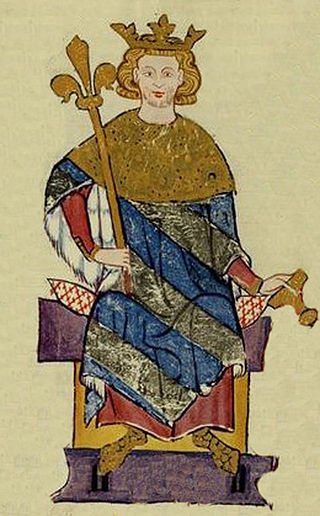
Wenceslaus II Přemyslid was King of Bohemia (1278–1305), Duke of Cracow (1291–1305), and King of Poland (1296–1305).

Matthias Corvinus was King of Hungary and Croatia from 1458 to 1490, as Matthias I. After conducting several military campaigns, he was elected King of Bohemia in 1469 and adopted the title Duke of Austria in 1487. He was the son of John Hunyadi, Regent of Hungary, who died in 1456. In 1457, Matthias was imprisoned along with his older brother, Ladislaus Hunyadi, on the orders of King Ladislaus the Posthumous. Ladislaus Hunyadi was executed, causing a rebellion that forced King Ladislaus to flee Hungary. After the King died unexpectedly, Matthias's uncle Michael Szilágyi persuaded the Estates to unanimously proclaim the 14-year-old Matthias as king on 24 January 1458. He began his rule under his uncle's guardianship, but he took effective control of government within two weeks.

The Hussite Wars, also called the Bohemian Wars or the Hussite Revolution, were a series of civil wars fought between the Hussites and the combined Catholic forces of Holy Roman Emperor Sigismund, the Papacy, and European monarchs loyal to the Catholic Church, as well as various Hussite factions. At a late stage of the conflict, the Utraquists changed sides in 1432 to fight alongside Roman Catholics and opposed the Taborites and other Hussite factions. These wars lasted from 1419 to approximately 1434.
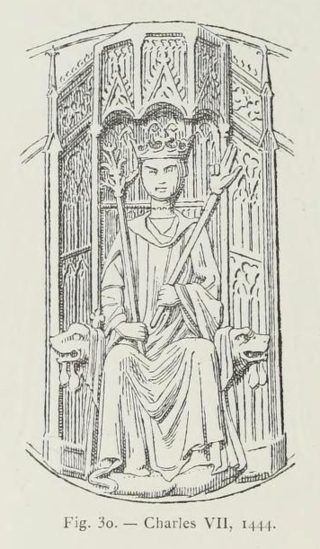
The Pragmatic Sanction of Bourges, issued by King Charles VII of France, on 7 July 1438, required a General Church Council, with authority superior to that of the papacy, to be held every ten years, required election rather than appointment to ecclesiastical offices, prohibited the pope from bestowing and profiting from benefices, and forbade appeals to the Roman Curia from places further than two days' journey from Rome. The Pragmatic Sanction further stipulated that interdict could not be placed on cities unless the entire community was culpable. The king accepted many of the decrees of the Council of Basel without endorsing its efforts to coerce Pope Eugene IV.
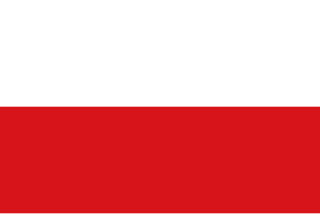
Although the Kingdom of Bohemia, both of the Lusatias, the Margraviate of Moravia, and Silesia were all under Habsburg rule, they followed different paths of development. Moravians and Silesians had accepted the hereditary right of the Austrian Habsburgs to rule and thus escaped the intense struggle between native estates and the Habsburg monarchy that was to characterize Bohemian history. In contrast, the Bohemian Kingdom had entrenched estates that were ready to defend what they considered their rights and liberties. The Habsburgs pursued a policy of centralization and conflict arose, which was further complicated by ethnic and religious issues.

The Taborites, were a faction within the Hussite movement in the medieval Lands of the Bohemian Crown. The Taborites were sometimes referred to as the Picards, a term used for groups which were seen as extreme in their rejection of traditional Catholic practices and societal norms, for example advocation for communal living.
The Transylvanian peasant revolt, also known as the peasant revolt of Bábolna or Bobâlna revolt, was a popular revolt in the eastern territories of the Kingdom of Hungary in 1437. The revolt broke out after George Lépes, bishop of Transylvania, had failed to collect the tithe for years because of a temporary debasement of the coinage, but then demanded the arrears in one sum when coins of higher value were again issued. Most commoners were unable to pay the demanded sum, but the bishop did not renounce his claim and applied interdict and other ecclesiastic penalties to enforce the payment.

The Kingdom of Bohemia, sometimes referenced in English literature as the Czech Kingdom, was a medieval and early modern monarchy in Central Europe. It was the predecessor state of the modern Czech Republic.
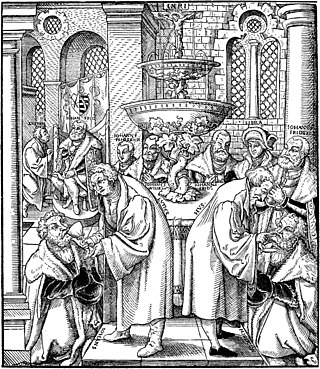
Utraquism, also called Calixtinism, was a belief amongst Hussites, a reformist Christian movement based on the Czech lands, that communion under both kinds should be administered to the laity during the celebration of the Eucharist. The Czech people had first been Christianized by missionaries Saints Cyril and Methodius, who introduced the Byzantine Rite in the Old Church Slavonic liturgical language and an earlier form of Communion in both kinds, only for the Roman Rite in Ecclesiastical Latin, which is less easily understood by speakers of Old Czech, to later be imposed by force upon the Czech people by bishops based in the Holy Roman Empire. As a cultural memory is believed to have survived in the interim, Communion in both kinds was a principal dogma of the Hussites and one of the Four Articles of Prague.

Vladislaus II, also known as Vladislav, Władysław or Wladislas, was King of Bohemia from 1471 to 1516 and King of Hungary and King of Croatia from 1490 to 1516. As the eldest son of Casimir IV Jagiellon, he was expected to inherit the Crown Kingdom of Poland and adjacent Grand Duchy of Lithuania. George of Poděbrady, the Hussite ruler of Bohemia, offered to make Vladislaus his heir in 1468. George needed Casimir's support against the rebellious Roman Catholic noblemen and their ally King of Hungary Matthias Corvinus. The Diet of Bohemia elected Vladislaus king after George's death, but he could rule only Bohemia proper because Matthias, whom the Roman Catholic nobles had elected king, occupied adjacent Moravia, and further east of Silesia in southeastern Germany and both Lusatias. Vladislaus tried to reconquer the four provinces with his father's assistance but was repelled by Matthias.

In the Late Middle Ages, the Kingdom of Hungary, a country in Central Europe, experienced a period of interregnum in the early 14th century. Royal power was restored under Charles I (1308–1342), a scion of the Capetian House of Anjou. Gold and silver mines opened in his reign produced about one third of the world's total production up until the 1490s. The kingdom reached the peak of its power under Louis the Great (1342–1382) who led military campaigns against Lithuania, southern Italy and other faraway territories.

The Bohemian Reformation, preceding the Reformation of the 16th century, was a Christian movement in the late medieval and early modern Kingdom and Crown of Bohemia striving for a reform of the Catholic Church. Lasting for more than 200 years, it had a significant impact on the historical development of Central Europe and is considered one of the most important religious, social, intellectual and political movements of the early modern period. The Bohemian Reformation produced the first national church separate from Roman authority in the history of Western Christianity, the first apocalyptic religious movement of the early modern period, and the first pacifist Protestant church.
Religious peace of Kutná Hora was concluded in March 1485 by the Czech lands Diet in Kutná Hora between Utraquist Hussites and Roman Catholics. The agreement between representatives of both sides, reached after meeting from 13 March to 20 March, declared the agreement from the Basel Council the basic law of the land. The Utraquist and the Catholic faiths were declared equal in front of the law, and the religious peace (Landfried) was declared for the following 31 years. This agreement finished a long series of religious conflicts in the Czech lands and constituted a definitive end to the Hussite Wars. The Diet in 1512 confirmed the agreement and extended it in perpetuity. Religious peace and tolerance helped for development of the land, but it contributed to the future conflicts of interests between middle-class and nobility.
The history of the inquisition in the Czech lands spans nearly two and a half centuries, beginning in 1257. However, it can be said to have functioned consistently for only about 100 years, from around 1315/1318 to around 1415. This church institution, established to combat heresies, took on a rather specific form in this country, as from the mid-14th century it was placed under the direct control of the Archbishop of Prague, whereas the norm was for the Inquisition to be subordinated solely to the Holy See.
References
- 1 2 3 Stieber 1978, p. 163.
- ↑ Janišová & Janiš 2016, p. 187.
- ↑ Sedlar 1994, p. 187.
- ↑ Šmahel 2011, p. 163.
